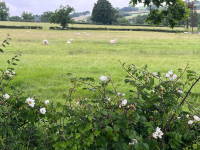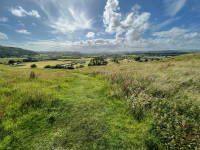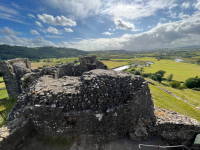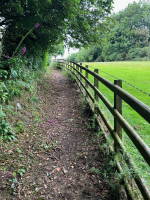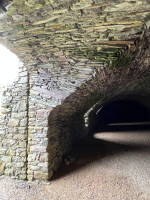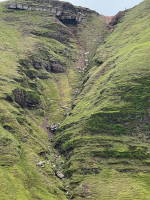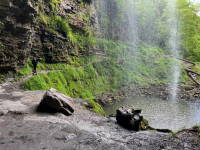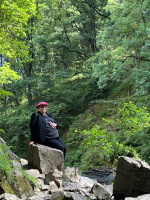Travelogue
Mar. 24th, 2024 07:45 amChecked out of our hotel in Madrid, rode two stops on the subway to the southern train station, and took a half-hour high-speed train ride (the overhead monitor said 216 km/h at least once) to Toledo, where even the modern train station is gorgeous Moorish-inspired architecture.


Caught a cab up the hill... and up the hill... and through a maze of twisty little passages from which we could have reached out the cab windows and touched the walls on either side. Old-town Toledo is very much still a medieval city in its construction, with nothing resembling a street grid and few calles (which would be called alleys or footpaths in the US) running farther than 50 m in one direction or by one name.
Our hotel's check-in time wasn't for several hours, so we left our luggage with the desk clerk and walked 100 m to visit the Cathedral, perhaps the biggest tourist attraction in Toledo. There's been a church on this site for about 2000 years, since Bishop Eugenius; it became a Cathedral and the spiritual/political/cultural center of Spain in the 7th century under Bishop Ildefonso, to whom the BVM appeared and gave a rich robe as a sign that this was the place to build a Cathedral; and the current building was constructed (presumably after a period of serving as a mosque) in the 13th-15th centuries, with a few later decorative additions. Pictures to follow.
After a couple of hours in the Cathedral, we returned to the hotel, checked in, and fell asleep. Got up about 6 PM, went out for supper (which was tricky, as most restaurants were closed or closing at this time), visited the (free admission) excavated Roman baths, then found a spot in one of the countless pedestrian plazas to wait for the evening religious procession. It's Holy Week in Spain, so there will be at least one religious procession almost every day up through Easter Sunday, each sponsored by a different church in town. The information booth near the Cathedral has a helpful pamphlet listing the starting times, routes, and dramatis personae of each procession, but it doesn't indicate how long each procession takes; the plaza we picked was about halfway through the route, and the procession reached us about two hours after its starting time. Pictures to follow.

This is the shower fixture in the hotel. From this picture, without manipulating any controls, you can figure out how it works: the left knob is water temperature (with a recommended 38°C highlighted), so the right knob must be water volume, and the pull-knob in the middle is shower/spigot. Temperature and volume are the controls I actually want in a shower -- or a sink for that matter -- not how-much-hot and how-much-cold, much less how-much-and-if-it's-a-lot-it's-hot. Why can't American plumbing manufacturers figure this out?
On the other hand, the "climate control system" in the room has two settings: on and off. I turned it on and got a minute or so of cool air, after which it switched into "heat" mode (presumably because it's March; the climate control system hasn't noticed the heat wave that has covered Spain for the past week). We would have opened the window to get outside air circulation, but the window is actually a door that opens onto the next door neighbor's patio, which feels a little creepy.


Caught a cab up the hill... and up the hill... and through a maze of twisty little passages from which we could have reached out the cab windows and touched the walls on either side. Old-town Toledo is very much still a medieval city in its construction, with nothing resembling a street grid and few calles (which would be called alleys or footpaths in the US) running farther than 50 m in one direction or by one name.
Our hotel's check-in time wasn't for several hours, so we left our luggage with the desk clerk and walked 100 m to visit the Cathedral, perhaps the biggest tourist attraction in Toledo. There's been a church on this site for about 2000 years, since Bishop Eugenius; it became a Cathedral and the spiritual/political/cultural center of Spain in the 7th century under Bishop Ildefonso, to whom the BVM appeared and gave a rich robe as a sign that this was the place to build a Cathedral; and the current building was constructed (presumably after a period of serving as a mosque) in the 13th-15th centuries, with a few later decorative additions. Pictures to follow.
After a couple of hours in the Cathedral, we returned to the hotel, checked in, and fell asleep. Got up about 6 PM, went out for supper (which was tricky, as most restaurants were closed or closing at this time), visited the (free admission) excavated Roman baths, then found a spot in one of the countless pedestrian plazas to wait for the evening religious procession. It's Holy Week in Spain, so there will be at least one religious procession almost every day up through Easter Sunday, each sponsored by a different church in town. The information booth near the Cathedral has a helpful pamphlet listing the starting times, routes, and dramatis personae of each procession, but it doesn't indicate how long each procession takes; the plaza we picked was about halfway through the route, and the procession reached us about two hours after its starting time. Pictures to follow.

This is the shower fixture in the hotel. From this picture, without manipulating any controls, you can figure out how it works: the left knob is water temperature (with a recommended 38°C highlighted), so the right knob must be water volume, and the pull-knob in the middle is shower/spigot. Temperature and volume are the controls I actually want in a shower -- or a sink for that matter -- not how-much-hot and how-much-cold, much less how-much-and-if-it's-a-lot-it's-hot. Why can't American plumbing manufacturers figure this out?
On the other hand, the "climate control system" in the room has two settings: on and off. I turned it on and got a minute or so of cool air, after which it switched into "heat" mode (presumably because it's March; the climate control system hasn't noticed the heat wave that has covered Spain for the past week). We would have opened the window to get outside air circulation, but the window is actually a door that opens onto the next door neighbor's patio, which feels a little creepy.

























